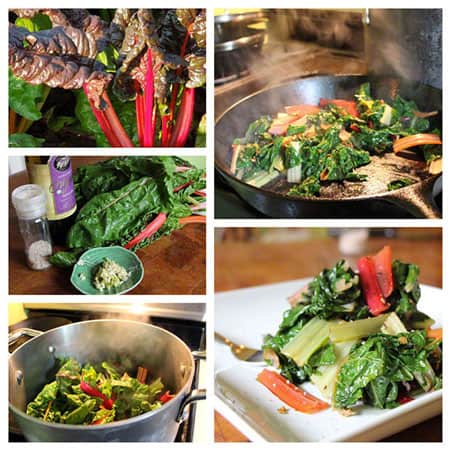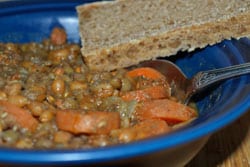Chard will always be there for you. Like a reliable friend, it is one of the greatest, and often least appreciated, of all the gifts from your local farmer (or garden).
Chard’s long, thick stalks have wide, glossy green leaves that may be smooth or curly, depending on the variety. The stalk comes in many colors, from white to green to brilliant red, yellow, and pink. At many farmers markets you’ll see the flashy Ruby Red and Bright Lights varieties. They are glamorous and hard to resist, but the old-fashioned varieties with white stems and green leaves are even tastier.
Not only is chard giving, it’s forgiving too. It’s much more heat-resistant than spinach, grows well under most weather and soil conditions, and is disease resistant and bug resistant too. After harvesting, the inner leaves come back quickly, so you’ll see chard at farmers markets from early June clear through Thanksgiving. Because it’s always there, you might take it for granted, but, as with a good friend, you shouldn’t.
Chard is as close to perfect as a vegetable can get–a low-calorie, high-nutrition green with a mildly sweet, clean taste. It’s also a fast food. Tender young chard leaves can be eaten raw, adding a beet-like flavor to salads and sandwiches. Larger stalks and leaves can be blanched in boiling water, or sauteed up in a matter of minutes, quick and easy. Then toss the cooked chard into pasta with olive oil and garlic, add to omelets and frittatas, or use instead of spinach in your favorite recipe.
Chard stalks and leaves are delicious, and there is no reason to discard the stems as many American recipes instruct. French or Italian recipes, on the other hand, often tell you to use just the stems and reserve the leaves for another purpose. That “other purpose” was revealed by the great food writer Richard Olney who wrote in Simple French Food (1977) that “the green leafy parts . . . are usually fed to the rabbits and the ducks.” I’m sure they make a fine treat for rabbits and ducks, but I recommend the obvious – eat the stems, leaves, and all!
Swiss chard Italian Style from Farm Fresh Now!
- 2 pounds Swiss chard (2 or 3 bunches), rinsed and coarsely chopped
- 4 cloves garlic
- Sea salt and hot red pepper flakes
- 4 tablespoons olive oil, or 2 Tb butter and 2 Tb olive oil
- fresh ground pepper
- Place the chard in a large stockpot with plenty of water still clinging to it and set on medium-high heat. When it begins to sizzle, stir and cover. Reduce heat to medium and cook until chard is wilted but still has texture and the leaves have turned dark green, about 10 minutes.
- Remove from heat.
- Heat 2 tablespoons of oil in a skillet over medium-low heat. Add the garlic and cook until golden, about 5 minutes.
- Add the chard to the skillet after squeezing out some of the liquid. Cook, stirring, until the chard has wilted and the garlic is cooked, about 10 minutes. Season to taste with salt and pepper.
- Transfer to a warmed platter and drizzle with the remaining olive oil or dot with butter and serve.
Serves 4 as a main course.
The best way to enjoy healthy, seasonal produce is to buy it from your local farmer or grow it yourself. To locate the nearest farmers’ market or farm CSA near you, go to “Local Harvest” online.
Secrets of a Seasonal Cook
Article © Terra Brockman
Photo © Cara Cummings
Farm Fresh Now! is a project of The Land Connection, an educational nonprofit that preserves farmland, trains new farmers, and connects people with great locally-grown foods. This series is made possible with generous support from the Illinois Department of Agriculture.




 © 2024 Terroir Seeds | Underwood Gardens
© 2024 Terroir Seeds | Underwood Gardens